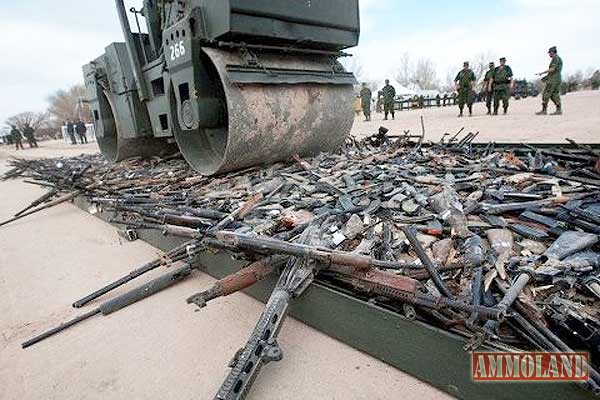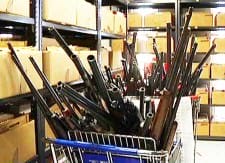By C.D. Michel


San Diego, CA –-(Ammoland.com)- For years some police agencies, particularly in Los Angeles, San Francisco, and other cities lead by politicians that push gun control, have forced citizens to forfeit legally owned firearms by seizing them overzealously.
Then making it practically impossible to get them back or even to sell them.
These forced firearms forfeitures are just one example of a much larger national problem of abusive property seizures and compelled asset forfeitures by the government.
Taking home seized firearms used to be an officer’s unofficial “perk.” But the raw number of firearms seized is also used to secure grant money, and has become the inappropriate yard stick promoted as the way to measure the success of crime control efforts.
It’s a game police and politicians play. Carefully spun press releases about getting guns “off the streets,” along with publicized photo-ops of guns being melted into rebar, are used to mislead the public into believing that lots of guns are being seized from gangs and violent criminals. But in reality, most guns are seized from the gun safes of harmless people who are not aware that they have become prohibited from possessing firearms by California’s complicated gun laws, or from otherwise law-abiding, clean-record gun collectors targeted with enticing “stings” to buy rare guns at cheap prices.
Police use the often accidental violations of California’s byzantine firearm regulations to justify confiscating entire gun collections and to pump up their seizure numbers. The seized collections of guns are ominously mislabeled as “arsenals,” and inappropriately condemned as the “inventory” of “arms dealers.” Surrendering the valuable gun collections to the government often becomes a heavy-handed conditional bargaining chip for a reasonable plea-bargain, effectively increasing “punishment” far beyond what is called for by law or justice.
The practice amounts to theft and extortion of the gun owner, and a fraud on the public – which is lulled into mistakenly believing that they are being made safer.
The U.S. Supreme Court might right some of these wrongs in Henderson v. United States.
Henderson lawfully owned a collection of firearms before he was arrested, and none of the guns were used in a crime. After serving his six-month sentence, Henderson – now prohibited from possessing firearms and in need of money – asked the FBI to transfer his firearms to a third party. The FBI refused. So Henderson asked the court to order the transfer. The district court also refused. So Henderson appealed.

The 11th U.S. Circuit Court of Appeals upheld the district court’s decision, reasoning that allowing Henderson to transfer or sell his firearms would give him “constructive possession” of a firearm, in violation of 18 U.S.C. Section 922(g)(1), the federal “felon-in-possession” statute.
Constructive possession is a court-created legal fiction used by courts to find illegal “possession” where physical possession does not actually exist. This way police can prosecute individuals when the inference of physical possession is strong, but there is no actual physical possession of illegal property. To find constructive possession, courts must do a fact-specific analysis and examine the totality of the circumstances to determine whether there is substantial evidence that the person has “dominion and control” over the firearm. There is no constructive possession if a transfer would strip the owner of any power to exercise dominion and control over the firearms, either directly or through the recipient.
Significantly, most courts acknowledge that a finding of dominion and control must be based on more than speculation.
Nonetheless, the Henderson court inappropriately used speculation about theoretical “risk” of future dominion and control over the firearms as the basis for finding there would be constructive possession of them. The court did not articulate how a sale of the guns to an unrelated third party would actually put Henderson in constructive possession of the firearms, and there was no evidence that Henderson actually would or could exert “dominion and control” over his guns once they were transferred. Instead, the court used the mere risk of Henderson gaining such dominion and control after the transfer to find that the guns would be constructively possessed if transferred.
In effect, in Henderson the Court of Appeals confounded the right to possess with the right to own, essentially finding that these are one in the same.
But they aren’t the same. Ownership is not possession, nor constructive possession.
Other courts have found, even where there was a possible or theoretical risk that a person could possibly gain dominion and control of firearms after their transfer, that constructive possession does not exist absent evidence that the defendant knowingly and intentionally could exert dominion and control. Some courts have even specifically recognized that Section 922(g) does not prohibit the government from transferring or gifting the firearms to “friends or relatives.” And the Bureau of Alcohol, Tobacco, Firearms and Explosives has similarly opined that the mere theoretical risk that a person might gain or exert dominion and control over firearms doesn’t constitute constructive possession.
So for example, the ATF says a wife can keep her guns in a home gun safe, locked away from her prohibited husband who lives with her but doesn’t have the key or combination.
Some courts have even warned of the potential for government abuse in allowing the forfeiture of property based on a theoretical future risk. These courts recognize that categorically prohibiting a person from facilitating the transfer or the sale of firearms based on speculation that the individual could constructively possess the firearms after the transfer, would “stretch the concept of ‘constructive possession’ … much too far.” Amen.

Even if theoretical “risk” or “possibility” were the correct legal standard for establishing constructive possession, any such risk could be alleviated through means much less severe than forfeiture of property to the government. Courts know that they can implement appropriate safeguards to “prevent [a felon] from constructively possessing the weapons and to ensure that they are properly sold and not otherwise misused.” And a court can condition the transfer “on the recipient’s written acknowledgement that returning the guns to [the felon] or honoring his instructions would aid and abet” a felon in the unlawful possession or attempted possession of a firearm. Other procedures could be court imposed to account for sales and disbursements, and to set deadlines.
Tellingly, in its opening brief to the Supreme Court, the government contradicts its earlier positions, and belatedly acknowledges that a person is not statutorily prohibited from transferring or selling their ownership interest in firearms simply because they have been convicted of a felony. In other words, now that it is facing critical scrutiny by the Supreme Court justices, the government is walking back its case and finally admitting, red-faced and at the 11th hour, that a person would not be in constructive possession of a firearm just because the government allowed their firearms transferred to a third party. But the government is nonetheless still clinging to the future risk theory, contradictorily arguing that the court was right to find facts supporting its reasoning that allowing Henderson to transfer his firearms to a third party “create[s] a significant risk that [he] would retain custody or control over the firearms, in violation of Section 922(g).” Again, there was no real evidence of such future risk, and even if future risk existed it could be eliminated by court imposed conditions. The government’s last minute about – face amounts to a different kind of corruption – intellectual corruption by a federal government emboldened by courts that let it get away with it.
Government abuse of asset forfeiture laws is a real problem. [For more on this see Why You May NOT Really Own Your Private Firearms Property ] And it’s not just with firearm seizures. Authorizing the transfer of someone’s firearms to an eligible third party will promote Section 922(g)’s goal of banning firearm possession by prohibited persons, while allowing property owners to recover the value of their property.
Police and prosecutors driven by politics or policy to seize and keep non-contraband property can always postulate about a theoretical risk that a prohibited individual might exert future control over transferred firearms. But absent evidence, theoretical speculation shouldn’t justify the forfeiture of someone’s valuable property, no matter what kind of property it is. At least when it comes to firearms, however, it seems like some lawyers or judges who perhaps don’t like guns generally feel that forfeiting them to the government is a desirable political end, justifying the use of unfounded theoretical future risk constructs as the means to expand the doctrine of constructive possession and thereby effectuate the politics of gun control.
Civil rights attorney Chuck Michel is a former prosecutor and head of Michel & Associates PC in Long Beach. The firm’s clients include the NRA, California Rifle & Pistol Association, firearm manufacturers, wholesalers and retailers, and individual gun owners.
About:
CalGunLaws.com is an online research resource designed primarily for use by attorneys and interested firearm owners. CalGunLaws.com strives to provide easy access to and facilitate understanding of the multitude of complex federal, state, and local firearm laws and ordinances, administrative and executive regulations, case law, and past and current litigation that defines the California firearms regulatory scheme in theory and practice. CalGunLaws.com is designed and organized to make it easy to research the law and to locate source materials and related information. All of the articles are cross referenced. Note the two sections on the right: Related Items and Related Law. Related Items will take you to any article related to the one you are currently viewing. Related law takes you to the related law and statutes for the item you are looking at.
